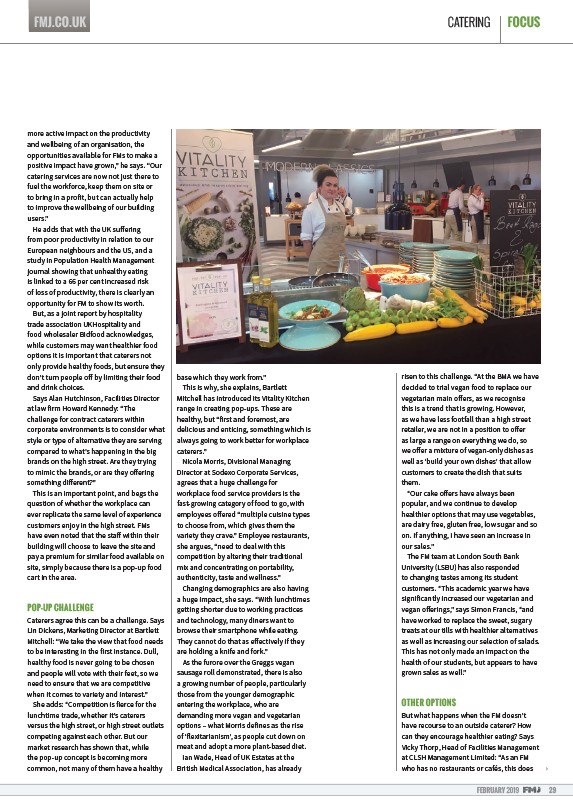
FMJ.CO.UK CATERING FOCUS
FEBRUARY 2019 29
more active impact on the productivity
and wellbeing of an organisation, the
opportunities available for FMs to make a
positive impact have grown,” he says. “Our
catering services are now not just there to
fuel the workforce, keep them on site or
to bring in a profit, but can actually help
to improve the wellbeing of our building
users.”
He adds that with the UK su
ering
from poor productivity in relation to our
European neighbours and the US, and a
study in Population Health Management
journal showing that unhealthy eating
is linked to a 66 per cent increased risk
of loss of productivity, there is clearly an
opportunity for FM to show its worth.
But, as a joint report by hospitality
trade association UKHospitality and
food wholesaler Bidfood acknowledges,
while customers may want healthier food
options it is important that caterers not
only provide healthy foods, but ensure they
don’t turn people o
by limiting their food
and drink choices.
Says Alan Hutchinson, Facilities Director
at law firm Howard Kennedy: “The
challenge for contract caterers within
corporate environments is to consider what
style or type of alternative they are serving
compared to what’s happening in the big
brands on the high street. Are they trying
to mimic the brands, or are they o
ering
something di
erent?”
This is an important point, and begs the
question of whether the workplace can
ever replicate the same level of experience
customers enjoy in the high street. FMs
have even noted that the sta
within their
building will choose to leave the site and
pay a premium for similar food available on
site, simply because there is a pop-up food
cart in the area.
POP-UP CHALLENGE
Caterers agree this can be a challenge. Says
Lin Dickens, Marketing Director at Bartlett
Mitchell: “We take the view that food needs
to be interesting in the first instance. Dull,
healthy food is never going to be chosen
and people will vote with their feet, so we
need to ensure that we are competitive
when it comes to variety and interest.”
She adds: “Competition is fierce for the
lunchtime trade, whether it’s caterers
versus the high street, or high street outlets
competing against each other. But our
market research has shown that, while
the pop-up concept is becoming more
common, not many of them have a healthy
base which they work from.”
This is why, she explains, Bartlett
Mitchell has introduced its Vitality Kitchen
range in creating pop-ups. These are
healthy, but “first and foremost, are
delicious and enticing, something which is
always going to work better for workplace
caterers.”
Nicola Morris, Divisional Managing
Director at Sodexo Corporate Services,
agrees that a huge challenge for
workplace food service providers is the
fast-growing category of food to go, with
employees o
ered “multiple cuisine types
to choose from, which gives them the
variety they crave.” Employee restaurants,
she argues, “need to deal with this
competition by altering their traditional
mix and concentrating on portability,
authenticity, taste and wellness.”
Changing demographics are also having
a huge impact, she says. “With lunchtimes
getting shorter due to working practices
and technology, many diners want to
browse their smartphone while eating.
They cannot do that as e
ectively if they
are holding a knife and fork.”
As the furore over the Greggs vegan
sausage roll demonstrated, there is also
a growing number of people, particularly
those from the younger demographic
entering the workplace, who are
demanding more vegan and vegetarian
options – what Morris defines as the rise
of ‘flexitarianism’, as people cut down on
meat and adopt a more plant-based diet.
Ian Wade, Head of UK Estates at the
British Medical Association, has already
risen to this challenge. “At the BMA we have
decided to trial vegan food to replace our
vegetarian main o
ers, as we recognise
this is a trend that is growing. However,
as we have less footfall than a high street
retailer, we are not in a position to o
er
as large a range on everything we do, so
we o
er a mixture of vegan-only dishes as
well as ‘build your own dishes’ that allow
customers to create the dish that suits
them.
“Our cake o
ers have always been
popular, and we continue to develop
healthier options that may use vegetables,
are dairy free, gluten free, low sugar and so
on. If anything, I have seen an increase in
our sales.”
The FM team at London South Bank
University (LSBU) has also responded
to changing tastes among its student
customers. “This academic year we have
significantly increased our vegetarian and
vegan o
erings,” says Simon Francis, “and
have worked to replace the sweet, sugary
treats at our tills with healthier alternatives
as well as increasing our selection of salads.
This has not only made an impact on the
health of our students, but appears to have
grown sales as well.”
OTHER OPTIONS
But what happens when the FM doesn’t
have recourse to an outside caterer? How
can they encourage healthier eating? Says
Vicky Thorp, Head of Facilities Management
at CLSH Management Limited: “As an FM
who has no restaurants or cafés, this does